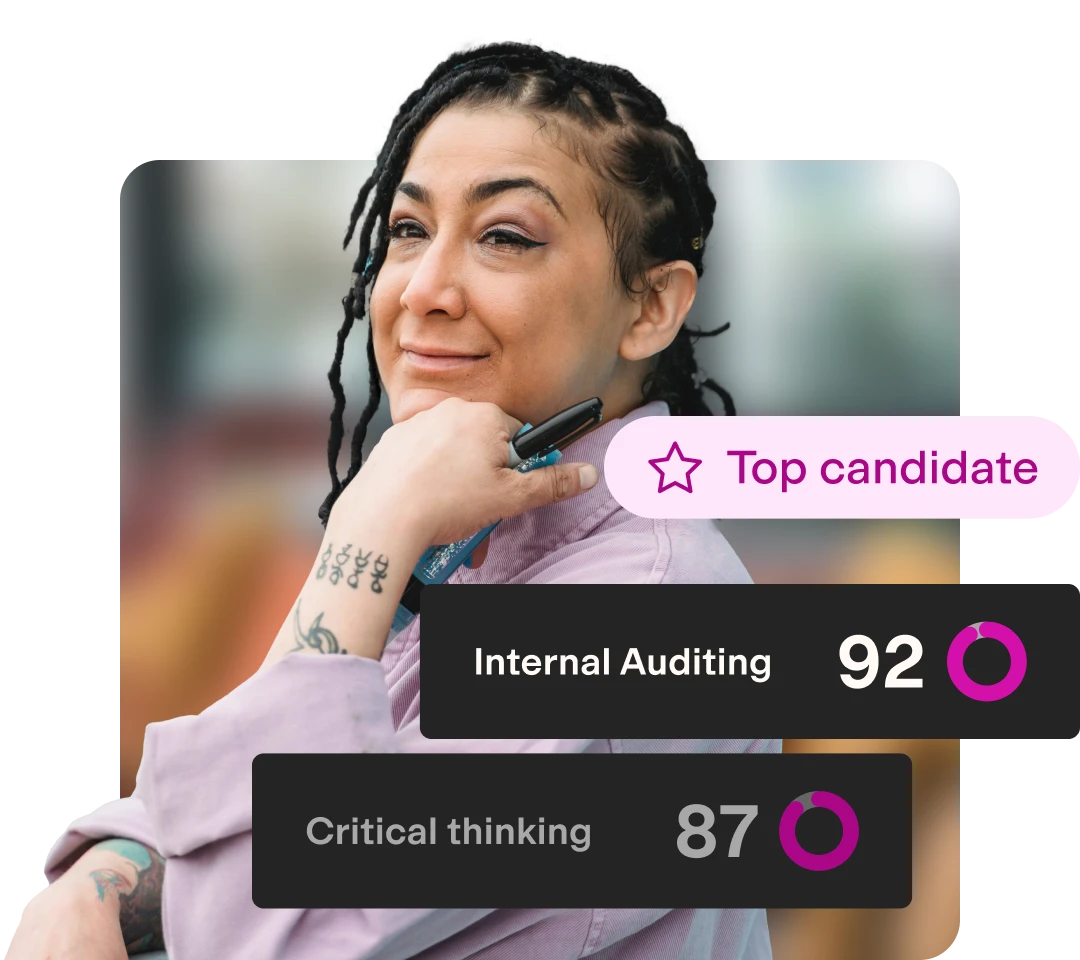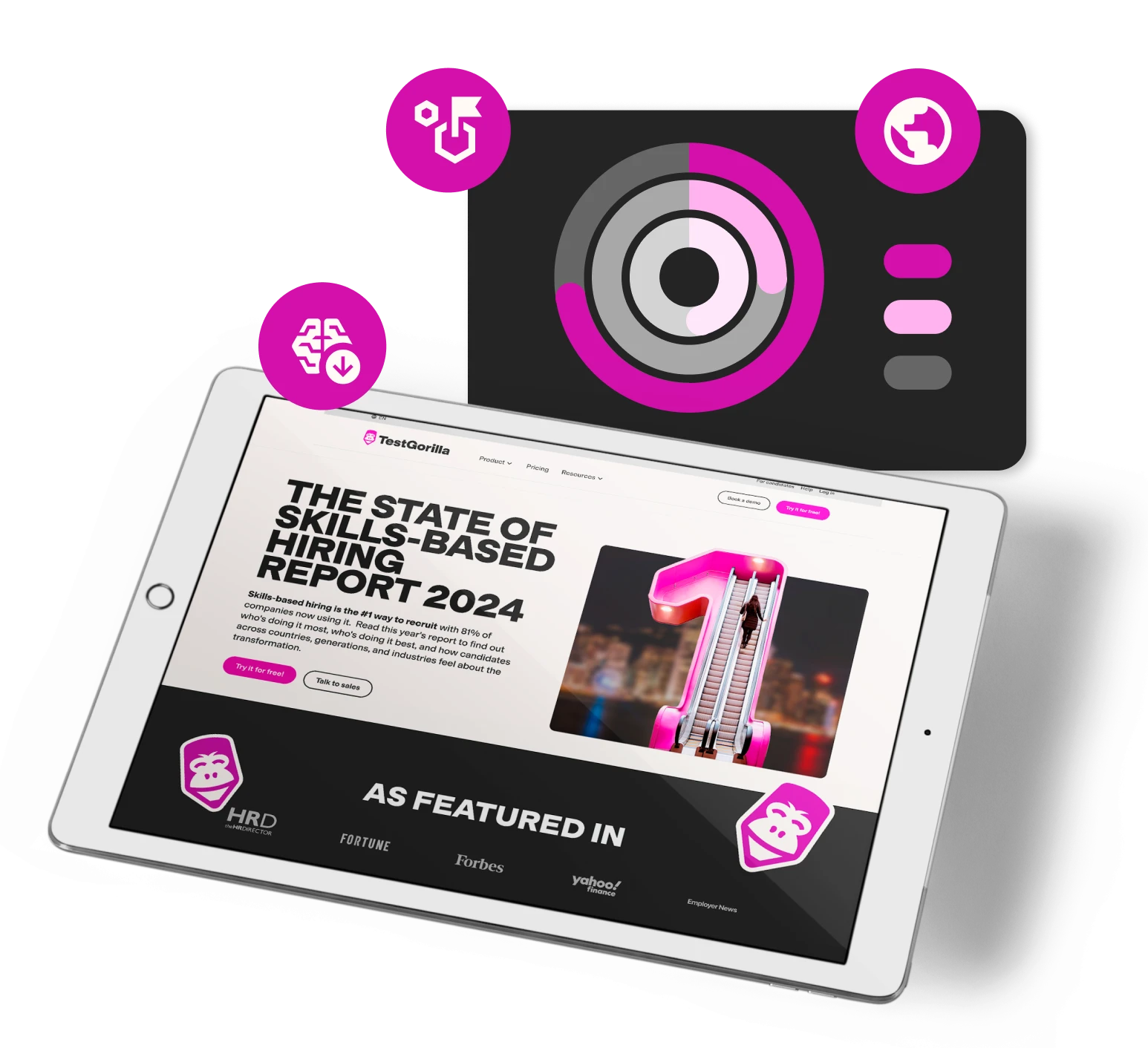Skills-based hiring hub
You'll find everything you need to know about skills-based hiring, plus a range of useful blogs and resources, right here in our hub.
What is skills-based hiring?
Skills-based hiring is a recruitment strategy where evidence of candidates' skills, rather than information about their experience or where they were educated, is used to make screening decisions.
Employers who practice skills-based hiring will set specific job-relevant skills criteria, and test for these skills using pre-employment tests or work-related tasks.
Frequently asked questions
Find answers below to some frequently asked questions about skills-based hiring
Read more
Skills vs. experience: What matters more for hiring?
A recent study by Korn Ferry estimates that by 2030, more than 85 million jobs will sit empty due to a lack of talent. [1] With fewer qualified workers, businesses must ensure their recruitment strategies are effective so they can fill their open positions with the right people. However, so many companies are still using outdated candidate screening methods – like resumes. For instance, we surveyed 1,500 employers in 2023 and found that 82% still use resume screening. Meanwhile, 69% think that resumes can tell them all they need to know about a candidates’ competencies. Our guess? Employers continue to rely on resumes because they mistakenly believe experience is the key to finding the right talent. We’re here to tell you that experience matters less than skills – and prioritizing experience can lead to missed opportunities, mis-hires, and more. Below, we help you see why focusing on skills vs. experience can help you find the right people for your roles and weather talent shortages.
Why you should use a skills ontology: The foundation of strategic, skills-based hiring
In a recent Gartner survey of HR managers, 47% admitted they didn’t know what skills gaps existed in their current workforce. [1] This finding is surprising given this information's crucial role in effective recruitment, strategic workforce management, and succession planning. It’s even more astonishing considering there’s a dedicated tool designed to help organizations understand their workforce’s skills: skills ontologies. Some organizations dismiss skills ontologies as overly complex, academic, or expensive exercises despite their benefits. Our opinion? They’re wrong. In this article, we argue for the adoption of skills ontologies to support skills-based hiring. We also discuss the benefits they offer organizations and some common pitfalls to avoid.
Do you need a college degree to get a good job?
Dropping degree requirements from job postings is all the hype right now. Mounting evidence suggests people need skills – not degrees – to succeed at work and that bias, favoritism, and inefficiency plague degree-based hiring. Many employers claim to have changed their ways, but few actually have. So, do you need a college degree to get a good job? Unfortunately, you still do. But you shouldn’t. In this piece, we expose how employers are paying lip service to dropping degree requirements. We also discuss why employers might be hung up on credentials and why they must ditch these requirements to enable candidates to show what they can actually do.
The State of Skills-Based Hiring
In the world's only annual report on skills-based hiring, we deep dive into the revolutionary recruitment trend to find out how employers are leveraging this approach, how it’s affecting candidate experience in the current job market, and what the adoption of skills-based hiring practices means for diversity efforts across organizations.
Are you a recruiter in tech or finance?
For data-driven insights about skills-based hiring in the tech and finance industries, check out our Tech and Finance reports. These resources are designed to help hiring managers in these industries implement skills-based hiring.
Skills-based hiring news
Can skills-based hiring solve tech’s diversity problem? The data says yes.
“Experience matters. We hire old people. (And young people, too).” [1] This bold 2021 job ad by tech startup RelevantDB quickly drew attention to tech’s long-standing diversity problem when it comes to hiring older workers. However, tech’s diversity issue isn’t just about the lack of older workers. Data shows that the industry also tends to hire fewer women, Black and Latinx workers, and individuals with disabilities. Despite recent contractions in the job market, tech is expected to expand more quickly than most other industries over the next few years. [2] This growth makes tech’s diversity issue urgent, as barriers to entry and a lack of inclusivity could become more ingrained if the issue is left unchecked. Our take on solving this issue? Embracing skills-based hiring is a good place to start. In this article, we dive into the tech industry’s lack of diversity and look at how a skills-based approach to recruitment can transform it.
Why do younger generations prefer skills-based hiring?
According to a recent survey for our 2024 State of Skills-Based Hiring report, 68% of employees prefer a skills-based hiring process. For 25 to 34-year-olds, this number goes up to 82%. The question that naturally follows is – what makes skills-based hiring so appealing to younger workers? In this article, we take a look at millennial and Gen Z workers and what drives their preference for skills-centric recruitment processes.
Why is the federal government prioritizing skills-based hiring?
The federal government is the largest employer in the US, with close to 3 million workers around the country. [1] Despite this, the government’s approach to hiring hasn’t changed significantly in decades – until now. Over the last few years, a clear shift to skills-based hiring has emerged. This shift challenges the “paper ceiling” – a metaphor for the unofficial barriers that prevent skilled individuals without formal degrees from accessing certain career opportunities. So, what does this shift mean for candidates and private employers? In this article, we outline the steps the US government is taking to prioritize skills in civil service hiring and the reasons for it, and we share our take on how it impacts candidates and private employers.
The science behind skills-based hiring
5 science-backed best practices for cognitive ability testing
Cognitive ability tests are a great tool for identifying top candidates when used appropriately. However, while they certainly are popular and useful, tests of cognitive abilities should be used carefully. Using these tests haphazardly can potentially create unfair disadvantages or biases toward some groups, meaning you may overlook high-quality candidates or open your organization to legal risk. This blog will walk you through some best practices, based on the latest scientific insights, for cognitive ability testing. Read on to learn how to build a sound hiring process using cognitive ability tests.
A brief introduction to classical test theory
Science series materials are brought to you by TestGorilla’s team of assessment experts: A group of IO psychology, data science, psychometricians, and IP development specialists with a deep understanding of the science behind skills-based hiring. If you've ever sat for an exam, at school, during a job application, or for a professional certification, you've encountered the principles of test design firsthand. Although taking tests might be a routine experience, the underlying framework that ensures they work as intended remains a mystery to many. In this blog, we’ll explore the foundations of classical test theory and explain how this framework continues to inform test development processes today.
Understanding construct validity: Examples and FAQ
Skills tests are an excellent way to measure candidates’ skills and traits before hiring them. However, you need to ensure that the tools you use are accurate. Construct validity is one type of validity that helps you determine if your tests are measuring what you intend them to measure. In this article, we examine the construct validity definition, explore construct validity examples, discuss how TestGorilla evaluates the construct validity of our tests, and explain the importance of using valid tests.
Skills-based hiring has impact
Skills-based hiring is high-impact for employers and candidates alike – check out these stats.
of employers reduce mis-hires
of employers improve retention
of 25-34 year olds prefer it
associate it with landing dream jobs
of Asian & Arab employees accessed new opportunities
of Black employees accessed new opportunities
of employers improved diversity
agree that skills-based hires stay longer
Skills-based hiring is transformative. When we move past traditional requirements like mandatory college degrees, we empower ourselves as hiring managers. By valuing skills and competencies, we deepen our insight into what a role truly demands, leading to better hiring decisions.
Blogs about impact
Skills-based hiring reduces mis-hires for 90% of employers. Here’s why.
Despite an influx of labor from the tech layoffs, a cooling labor market, and access to more global talent than ever, 51% of employers are having difficulty finding top talent in 2024. What’s worse – even when you think you’ve found the right person for the job, there’s still a good chance it won’t work out. One study even showed that nearly 75% of recruiters admit to having hired the wrong person for a vacancy – wasting time, resources, and money. [1] Luckily, things are changing. We recently found that 90% of employers using skills-based hiring have seen a reduction in mis-hires. Why and how is a simple change in approach so effective at cracking this problem? In this guide, we dive into what skills-based hiring is, why it’s effective at reducing mis-hires, and how you can use it to land the best-suited candidates for your company.
How to retain talent with skills-based hiring
Losing talent can seriously disrupt growth and put your business on the back foot. If that’s not scary enough – replacing employees in today’s deprived labor markets is tough. It’s no surprise that retention is currently top of mind for most employers. [1] Despite this, the last few years have seen some of the worst turnover rates in decades [2], leaving employers confused and frustrated. So, what’s going wrong? Maybe you’re hiring people who were a flight risk to begin with. Perhaps you’re trying to fix problems when it’s already too late. Or maybe you’re using outdated retention strategies that don’t work anymore. Whatever the reason, we can help. You can avoid so much of the above with a single change to your hiring strategy. In this guide, we show you how skills-based hiring is the ultimate way to find – and keep – the best talent.
Hire faster and better with skills-first hiring
Ask any recruiter about the importance of skills and they would say it’s one of (if not the most) important factors when selecting a candidate. However, in traditional hiring, skills assessments come a lot later in the process than resume screening. And indeed, for decades, candidate selection has been synonymous with resume screening. Evaluating resumes and looking at degrees, job titles, and years of experience have been the cornerstones of the selection process. However, if that’s your way of doing things, you’re probably eliminating lots of candidates who have strong skills but a weak resume. A resume-first approach often fails to provide a comprehensive view of a candidate's true capabilities, leading to mismatches, costly mis-hires, and, in many cases, biases creeping in and influencing hiring decisions. Whether conscious or unconscious, biases on gender, ethnicity, or educational background can result in overlooking candidates with top skills and potential. To overcome this, some of the most forward-thinking companies have started using skills-first hiring. This approach helps find the right hire and build a workforce that's agile, diverse, and poised for success. Welcome to the skills-first revolution.
By region
Skills-based hiring around the world: Who’s leading the charge?
If you aren’t doing it yet, that’s ok: 58% of companies we surveyed only just adopted skills-based hiring in the past two years. But from the United States to Singapore, a skills-based approach is quickly becoming a popular way for recruiters to attract and retain global talent. The reasons for using skills-based hiring vary from region to region. In some parts of the world, organizations use it to streamline high-volume hiring. While in others, the focus is on making teams more diverse and equitable. Let’s take a closer look at how skills-based hiring works in the USA, UK, and the Asia-Pacific region. We’ll compare the reasons for implementing the practice—and the results of doing so. We’ll also highlight what these examples can teach us about creating a more diverse and higher-performing workforce.
Skills-based hiring is the latest US hiring trend – and these 5 states are getting it right
States across the US are implementing a skills-based approach to hiring and rewriting the rules to traditional hiring practices. Instead of evaluating candidates on their education and background, they’re going in search of diverse talent who have the skills needed for the job. This opens up opportunities to people who might miss out because they’ve been skilled through alternative routes (STARs) or don’t have a degree. However, not all states are created equal in their approaches to hiring and progress. In this piece, we look at how five US states are adopting skills-based hiring and what you can learn from them to attract the best talent for your own business.
Is skills-based hiring the latest APAC hiring trend?
The global skills shortage is ongoing. Many skilled workers are being turned away by employers because of a lack of formal education or experience on their resumes. Many employers are not offering workers learning and development opportunities even though 45% of workers say they would stay at their company longer if it invested in their growth.[1] Skills-based hiring is a proven strategy to locate, retain, and develop skilled workers. In fact, The State of Skills-Based Hiring 2024 found that 81% of employers globally are using skills-based hiring to identify talent. But do Asian-Pacific (APAC) countries, where the bulk of the world’s working population lives, fit into this? This article dives into the current skills-based hiring situation in prominent APAC countries to explore how companies are adapting, the role that governments play, and the cultural and social factors that are driving (or preventing) the benefits of skills-based hiring. Finally, we’ll take a look at how skills-based hiring can fill the gaps that the majority of APAC economies are experiencing and the lessons the rest of the world can learn. “APAC” can be an ambiguous term, so in this article, we’ll use it to refer to East and Southeast Asian countries as well as Oceania.
Should I switch to skills-based hiring?
Skills-based hiring practices can have a measurable impact on time-to-hire, cost-to-hire, retention, diversity, and number of mis-hires. But should you switch? Calculate your return on investment to help you make a decision.
How do I get started?
We've got plenty of content to help you get started with skills-based hiring. Watch the video about why you should test for skills first, dip into the blogs below, or read our case studies to learn how other companies are doing skills-based hiring.
Implement skills-based hiring in 4 steps
What’s the first rule of hiring? Ask any organizational psychologist and they will tell you: “job analysis, job analysis, job analysis”.
Conducting a job analysis of the role you’re hiring for to identify your requirements is key to ensuring you're looking for job-relevant skills, and is the first step to implementing skills-based hiring. Read about how to conduct a job analysis.
Blogs to help you get started
10 best practices to adopt skills-based recruitment and selection processes
Our 2023 State of Skills-Based Hiring report reveals that both hiring teams and candidates are increasingly dissatisfied with ineffective and unfair traditional recruitment practices. But hiring methods are changing. We found that 81% of companies are already embracing skills-based hiring. The best part? Candidates hired in this way are happier in their roles, stay longer, and perform better. We know skills-based hiring increases hiring ROI while reducing time-to-hire and employee churn. But we’re no strangers to its challenges either since we practice what we preach in our own organization. That’s why we’ve put together 10 best practices to help you get started with skills-based recruitment and selection.
How to adopt skills-based hiring: 6 tips for success (and 3 things to avoid)
I’ve been helping people implement skills-based hiring with TestGorilla for over 2 years now, and recently someone asked me which questions come up the most during onboarding calls. If we’re being literal about it, then the most common question I get asked during a call is “How are you?”, but if pleasantries didn’t count, it would be, “What are your recommended best practices?” Consider this blog post a culmination of all the times I’ve answered that question. Read on to learn about the steps I spend my days trying to get companies to follow when they adopt skills-based hiring.
4 simple ways to master skills-based hiring
For many employers, skills-based hiring has been a game-changer. It's helped them find top talent, boost diversity, and save time and money – despite an unfavorable job market. Unfortunately, not everyone is seeing these benefits, and we get how frustrating it can be. You’ve got the best intentions. Maybe you’re using tried and tested skills-based practices. Overall, you’re trying to change how you hire – and somehow, you’re still falling short. Don’t worry, though – we've got your back. We did some solid research to understand what’s happening. In this article, we break it all down for you and share four proven ways to help you hire better, faster, and cheaper with a skills-based approach.
By role
How to take a skills-based approach to blue-collar recruitment
Employers are finding it increasingly difficult to fill their blue-collar job openings. The Covid-19 pandemic and the Great Resignation have contributed to this hiring shortage, but attracting and retaining skilled blue-collar workers was an issue even previously. With older workers retiring and many younger workers opting for four-year degrees or white-collar work, companies need to adjust their blue-collar recruitment strategies.[1] Skills-based hiring locates talented workers by focusing on skills instead of education and prior job experience. Using skills assessments and structured interviews, and investing in upskilling and employee development, are all ways to take a skills-based approach to blue-collar recruitment. This article contains everything you need to know about taking a skills-based approach to blue-collar recruitment.
How to recruit for white-collar jobs using skills-based hiring
White-collar jobs can be really difficult to hire for because the roles and responsibilities of white-collar workers are often a blend of high-level hard and soft skills and experience. This makes tasks and roles can be hard to define. Traditional hiring practices seem to ignore this crucial question by gathering the fluid work responsibilities of white-collar jobs into singular job titles and organizational hierarchies. In other words, they use blue-collar hiring practices for white-collar jobs. With rapid ongoing changes in technology, consumer behaviors, and employee demands, this overly simplistic view of white-collar work compromises organizational agility, growth, innovation, diversity, and a positive employee experience.[1] On the other hand, adopting skills-based hiring practices and working models caters to the fluid responsibilities and requirements of white-collar work by centering skills over degrees, resumes, and cover letters during the hiring process. Let’s take a look at the skills necessary for such jobs before diving into six examples of white-collar jobs and how to hire for them.
How skills-based hiring is transforming entry-level hiring
Entry-level jobs are historically difficult to fill, with 41% of recruiters reporting that they are the hardest positions to hire for.[1] Although many employers blame entry-level talent shortages, the real culprit is traditional hiring methods that aren’t optimized to locate and retain entry-level talent. Outdated practices like cover letters, resumes, and inflating the worth of degrees disregard workers who may have little to no experience but have the skills to succeed. The result is a hiring catch-22: Candidates need experience to get a job, but they need a job to get experience. This isn’t just a nightmare for job-seekers. It severely limits an employer's talent pool, leading them to miss out on diverse candidates with fresh perspectives. Skills-based hiring levels the playing field by opening up entry-level positions to any skilled candidate, regardless of their background. Read on to discover how candidates and employers alike can benefit from skills-based entry-level hiring.
By industry
Hiring for startups: Should you hire for a short-term fit or the potential to scale?
When you’re launching a startup, building the right team is everything: 14% of startups fail due to not having the right people on board.[1] And yet, it’s fraught with complications. Let’s say you’ve identified social media as a key engine for your brand’s growth in the next six months. You know you need a dedicated team member to craft your strategy and manage your channels, but when it comes to hiring, you find yourself in a bind. One of your candidates is highly skilled in social media management and would undoubtedly maximize the effectiveness of your social media push in the short term – but their long-term career goals don’t align with your vision for the role. Your other candidate isn’t as experienced, so their effectiveness in the short term might be less impressive. However, they’re keen to progress with your company, and they have a broad range of additional marketing skills that could inform your other initiatives. Who do you prioritize: the candidate who provides the best short-term fit, or the one with the most potential to scale with you? This dilemma is one of the most challenging parts of HR for startups, and we’re here to help you navigate it. In this blog, we take you through the benefits and drawbacks of hiring for short-term fit vs. the potential to scale, when it’s appropriate to use each strategy, and the best practices for doing so.
Skills-based hiring in the healthcare industry
The healthcare industry is one of the largest in the US. The market size was valued at $359.2bn in 2022 and is projected to reach $781.5bn by 2030.[1] This massive industry is currently facing a massive talent gap. Thousands of healthcare workers are leaving the industry, and too few are coming in. This means the healthcare sector needs to attract talent, stay competitive, improve working conditions, and retain top employees. It’s certainly a tall order, but there’s a solid solution to each of these issues. Let’s take a look at the current state of the healthcare industry and how skills-based hiring helps fill talent gaps, hire better candidates, and retain workers.
What’s causing inequality in STEM, and is skills-based hiring the solution?
It’s well-known that STEM industries – industries under the umbrella of science, technology, engineering, and math – are some of the least diverse industries out there. Despite that the skills needed for a software engineer are not inherent to any race, gender, or other demographic categories, 93% of professional developers are men, more than 40% are White, and more than 98% do not have a disability.[1] Given that more than 90% of organizations that switched to skills-based hiring in 2022 saw an increase in diversity, it’s understandable for STEM leaders to consider skills-based hiring as an antidote – but can it work? This blog explores the different diversity issues plaguing STEM industries and how skills-based hiring can help.
Try skills-based hiring with TestGorilla
If you're looking for a pre-employment testing tool to use for skills-based hiring, try TestGorilla. We've got 400+ skills tests designed to help you hire top talent in a fair and data-driven way. Book a free consultation with our team or try for free today.
Read the latest!
Updated monthly to bring you fresh content about skills-based hiring and related HR topics. Search below to find content about skills-based hiring by industry, region, and role.
AI is not ready to interview job applicants. Here’s why.
AI (artificial intelligence) has helped many employers streamline their hiring processes, reduce time to hire, and save costs. Many employers are now even using AI to interview candidates. But what are the implications of this? Are these tools really ready to interview candidates without any human involvement? We don’t think so. However, there are ways to use AI safely and conscientiously in your hiring process. In this article, we look at some of the risks with AI interviews and share how to u
IQ tests for employment are obsolete – here’s what to do instead
IQ tests are popular for hiring, but there are better alternatives. Find out how to hire the best candidates with cognitive ability assessments and skills tests.
Posting interview questions online: Should you do it?
In April 2024, UK retailer the John Lewis Partnership announced it would publish interview questions for all roles on its website, allowing candidates to prepare their responses.[1] The HR community widely praised the move, particularly for its positive impact on neurodiverse people. These individuals are often underrepresented in the workforce and face barriers to employment, especially in traditional interview processes. In light of John Lewis’s announcement, it’s a good time to ask: Should
Can skills-based hiring solve tech’s diversity problem? The data says yes.
“Experience matters. We hire old people. (And young people, too).” [1] This bold 2021 job ad by tech startup RelevantDB quickly drew attention to tech’s long-standing diversity problem when it comes to hiring older workers. However, tech’s diversity issue isn’t just about the lack of older workers. Data shows that the industry also tends to hire fewer women, Black and Latinx workers, and individuals with disabilities. Despite recent contractions in the job market, tech is expected to expand mor
Skills-based hiring reduces mis-hires for 90% of employers. Here’s why.
Despite an influx of labor from the tech layoffs, a cooling labor market, and access to more global talent than ever, 51% of employers are having difficulty finding top talent in 2024. What’s worse – even when you think you’ve found the right person for the job, there’s still a good chance it won’t work out. One study even showed that nearly 75% of recruiters admit to having hired the wrong person for a vacancy – wasting time, resources, and money. [1] Luckily, things are changing. We recently
Why do younger generations prefer skills-based hiring?
According to a recent survey for our 2024 State of Skills-Based Hiring report, 68% of employees prefer a skills-based hiring process. For 25 to 34-year-olds, this number goes up to 82%. The question that naturally follows is – what makes skills-based hiring so appealing to younger workers? In this article, we take a look at millennial and Gen Z workers and what drives their preference for skills-centric recruitment processes.
Claim the job of your dreams with skills-based hiring
Today’s job market is challenging for employers and job seekers alike. While companies are struggling to fill their roles, candidates are having a tough time landing good jobs. It’s frustrating, right? You might work hard, try to gather relevant experience, take online courses, and more – only to get rejected. Or, you might think going after a job is pointless – even if you feel capable. We get it, and we’re here to help. Our latest research shows that skills-based hiring is the ultimate solut
4 simple ways to master skills-based hiring
For many employers, skills-based hiring has been a game-changer. It's helped them find top talent, boost diversity, and save time and money – despite an unfavorable job market. Unfortunately, not everyone is seeing these benefits, and we get how frustrating it can be. You’ve got the best intentions. Maybe you’re using tried and tested skills-based practices. Overall, you’re trying to change how you hire – and somehow, you’re still falling short. Don’t worry, though – we've got your back. We di
Does skills-based hiring scale? Your guide to using it as an org-wide recruitment strategy
With 73% of employers using skills-based hiring in 2023, the way we hire is truly evolving towards practices that focus on skills. Technology is also evolving to facilitate this shift. There’s a real need for employers to be able to reliably measure and quantify the skills that their applicants have, and software companies that specialize in building science-backed skills-based hiring solutions are there to meet that need. As a result, skills-based hiring solutions are more accessible than ever.
Skills-based and merit-based hiring are not the same: Here’s why
Recruitment is on the brink of a complete revolution. With growing intolerance for unfair hiring and nepotism, companies are under more pressure than ever to find top candidates while still providing equal opportunities for everyone. While many employers claim to be moving toward a fairer approach, several of them have made no tangible change in how they hire. College graduates are still snagging top jobs over those who are skilled but less privileged. The issue is that employers are now focus
Why is the federal government prioritizing skills-based hiring?
The federal government is the largest employer in the US, with close to 3 million workers around the country. [1] Despite this, the government’s approach to hiring hasn’t changed significantly in decades – until now. Over the last few years, a clear shift to skills-based hiring has emerged. This shift challenges the “paper ceiling” – a metaphor for the unofficial barriers that prevent skilled individuals without formal degrees from accessing certain career opportunities. So, what does this shi
4 reasons to use language agnostic coding tests in your hiring process
TestGorilla’s IP development and engineering teams have been working hard to update our platform’s coderunner. A major reason why we’re doing this is to make sure it can support language agnostic coding tests. We’re big fans of language agnostic coding tests, and this work represents an important development – not just for TestGorilla, but for the world of coding tests more widely. Things are changing, and testing universal coding skills in a language-specific environment just doesn’t cut it an




































